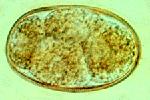Difference between revisions of "Ancylostomatoidea Structure and Function"
Jump to navigation
Jump to search
JamesSwann (talk | contribs) |
|||
| Line 25: | Line 25: | ||
== General Appearance == | == General Appearance == | ||
[[Image:Ancylostoma.jpg|thumb|right|150px|''Ancylostoma'' - Courtesy of the Laboratory of Parasitology, University of Pennsylvania School of Veterinary Medicine]] | [[Image:Ancylostoma.jpg|thumb|right|150px|''Ancylostoma'' - Courtesy of the Laboratory of Parasitology, University of Pennsylvania School of Veterinary Medicine]] | ||
| − | The superfamily '''Ancylostomatoidea''' contains the 'hookworms', 1-2 cm long bursate [[Nematodes|'''nematodes''']] which, together with the [[Strongyloidea|''' | + | The superfamily '''Ancylostomatoidea''' contains the 'hookworms', 1-2 cm long bursate [[Nematodes|'''nematodes''']] which, together with the [[Strongyloidea|'''Strongyloidea''']] and [[Trichostrongyloidea|'''Trichostrongyloidea''']], belong to the order '''Strongylida'''. |
| − | Unlike the rest of the [[ | + | Unlike the rest of the [[Strongyloidea]], the head is bent dorsally so that the buccal cavity forms a characteristic 'hook'. Members of the family have large buccal cavities which often contain teeth and cutting plates to allow the adult worms to embed their heads deeply into the mucosa of the small intestine. The large buccal cavity can be easily identified under the microscope and the configuration of teeth and cutting plates can be used to identify individual species. |
Revision as of 16:43, 16 July 2010
| This article is still under construction. |
Scientific Classification
General Appearance
The superfamily Ancylostomatoidea contains the 'hookworms', 1-2 cm long bursate nematodes which, together with the Strongyloidea and Trichostrongyloidea, belong to the order Strongylida.
Unlike the rest of the Strongyloidea, the head is bent dorsally so that the buccal cavity forms a characteristic 'hook'. Members of the family have large buccal cavities which often contain teeth and cutting plates to allow the adult worms to embed their heads deeply into the mucosa of the small intestine. The large buccal cavity can be easily identified under the microscope and the configuration of teeth and cutting plates can be used to identify individual species.
| Kingdom | Animalia |
| Phylum | Nematoda |
| Class | Secernentea |
| Order | Strongylida |
| Superfamily | Ancylostomatoidea |
| Family | Ancylostomatidae |
